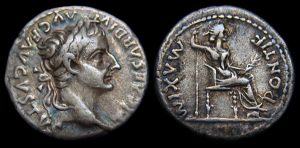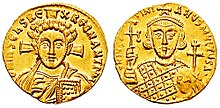Sermon preached by Rev’d Dr Emma Pennington at All Saints’ Cuddesdon on Sunday 22nd October 2017.
Reading: Matthew 22: 15-22.
Museums are wonderful places. You never know what you might come across. This summer after a hot morning lying on the beach at the Lido we found ourselves in the cool of the National Archaeological Museum of Venice. It wasn’t a venue on our wish-list of places to visit during our week’s stay in that water-bound city but our entrance ticket to the Doges Palace included the Archaeological Museum so we thought we would take a look. Wandering round those marble rooms during the heat of the day was as good as being in a fridge and slightly more interesting.
As I passed along a corridor of display cases something caught my attention. It was not just the twinkling colours of the coins that drew me to them but the vast numbers of them all neatly laid side by side. I went to have a closer look at this vast collection of over 9,000 coins dating from the Byzantine period all the way back to the early Greeks. As I went back in time suddenly I realised that I was looking at the very coins that were in circulation around the time of Jesus. The coin which Jesus holds in his hand in our Gospel account today.
Commonly known as the tribute penny from this very passage the silver denarius of the Emperor  Tiberius shows the Emperor’s head in profile surrounded by the inscription Tiberius Caesar Divi Augusti Filius Augustus Caesar Augustus Tiberius son of the Divine Augustus. On the reverse there is the image of a seated female figure holding an inverted spear and olive branch who is often identified as Livia, the wife of Augustus who was also deified but after her death. Though the figure could just be a personification of Pax or Peace. The imagery on the coin is therefore a very powerful one, asserting the authority of the Emperor who claims a divine mandate to rule and has brought peace and justice to the world. This little silver coin told you who was in charge, who was your lord and master, who had power over you and who owned this coin. As Jesus reminds us the coin very much belonged to the Emperor but he was also asking us a rather challenging question. The little piece of silver belongs to Caesar but do you?
Tiberius shows the Emperor’s head in profile surrounded by the inscription Tiberius Caesar Divi Augusti Filius Augustus Caesar Augustus Tiberius son of the Divine Augustus. On the reverse there is the image of a seated female figure holding an inverted spear and olive branch who is often identified as Livia, the wife of Augustus who was also deified but after her death. Though the figure could just be a personification of Pax or Peace. The imagery on the coin is therefore a very powerful one, asserting the authority of the Emperor who claims a divine mandate to rule and has brought peace and justice to the world. This little silver coin told you who was in charge, who was your lord and master, who had power over you and who owned this coin. As Jesus reminds us the coin very much belonged to the Emperor but he was also asking us a rather challenging question. The little piece of silver belongs to Caesar but do you?
It is clear from the context that the episode of the Tribute Penny is staged by the Pharisees to see if they can get Jesus into trouble. Like a good BBC Radio 4 Today interviewer, they are trying to wheedle out from Jesus a soundbite that they can then use to condemn him. If he teaches that it is lawful for us to pay our taxes to Rome then he would be accused of supporting the Roman occupation and lost his populist appeal. However, if he says that it is not lawful to pay taxes to the Emperor then they can accuse Jesus of insurrection and nicely get rid of his through the Roman courts.
In reply Jesus does not so much outwit them as turn the argument back onto them and reveal their own warped principals. Rather than answering their question Jesus asks to see a coin, the little silver coin which was minted in Rome, owned by the Emperor and due in taxation from the people. Jesus draws this hearers to look at it – whose head, whose face is on it? And by doing so he is also asking the question whose face rules and governs your life? If it is the Emperor then your life is hedged in by the power and authority and even the divinity of the face represented on this coin and your political relationship to this coin defines how you live your life. But if your allegiance is to God and God alone rather than the gods of Mammon then what does it matter what you do with this little piece of Roman property. It belongs to Rome so give it to Rome but give to God your life and your love.
In a week when we have heard that over 25 million adults are financially vulnerable, unable to keep up with domestic bills or meet credit commitments, Jesus’ question to the Pharisees seems very apposite. Who is it that rules your life, who or what do you allow to have power over you? Is it the face on the coin which we increasingly do not see or hold or is it our God in heaven?
In our post communion prayer today we will hear the words: ‘Holy and blessed God, you have fed us with the body and blood of your Son and filled us with your Holy Spirit, may we honour you, not only with our lips but in lives dedicated to the service of our Lord Jesus Christ’. Surely this extends to how we in our increasingly coinless world are to view our own financial obligations which seem to hold even greater monetary power over us than ever it did in the past. I wonder, if the face of Christ were imprinted on our coins rather than the head of the Queen, would we treat our financial transactions differently? Seeing the face of Christ would we not seek to honour him by sharing more easily what is the states, knowing that the one who has power and authority over us in not money or the Emperor but God himself.
During the age of Justinian II around 705 a new coin was indeed produced, the most beautiful coin of  gold. On one side of this solidus the Emperor Justinian looks out directly at you as he holds a cross and the patriarchal globe, just like the Emperors of Rome before him. But on the reverse is the image of the face of Christ with a cross crowning his head. One hand is raised in benediction and in the other he holds the book of the Gospels. In the one coin we find Jesus’ words epitomized: ‘Render to Caesar the things that are Caesars and to God the things that are Gods’. The two are not separate, church and state but reminds us that while we live in this world governed by credits and debits, figures of authority and worldly power, our identity, our allegiance and all our worldly goods are given up in honour of Christ and to the service of others. Amen.
gold. On one side of this solidus the Emperor Justinian looks out directly at you as he holds a cross and the patriarchal globe, just like the Emperors of Rome before him. But on the reverse is the image of the face of Christ with a cross crowning his head. One hand is raised in benediction and in the other he holds the book of the Gospels. In the one coin we find Jesus’ words epitomized: ‘Render to Caesar the things that are Caesars and to God the things that are Gods’. The two are not separate, church and state but reminds us that while we live in this world governed by credits and debits, figures of authority and worldly power, our identity, our allegiance and all our worldly goods are given up in honour of Christ and to the service of others. Amen.